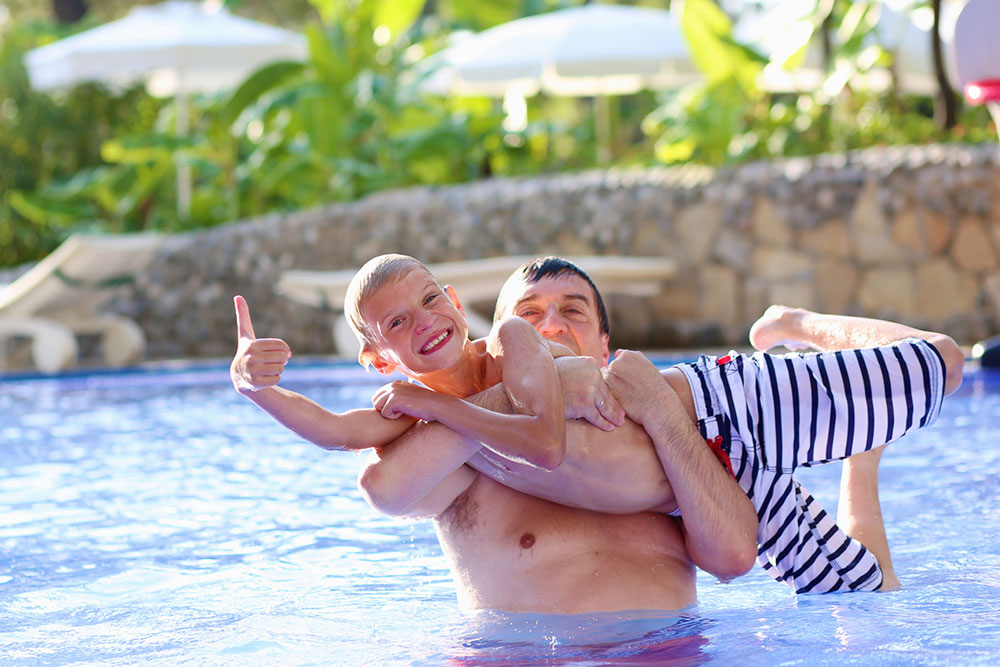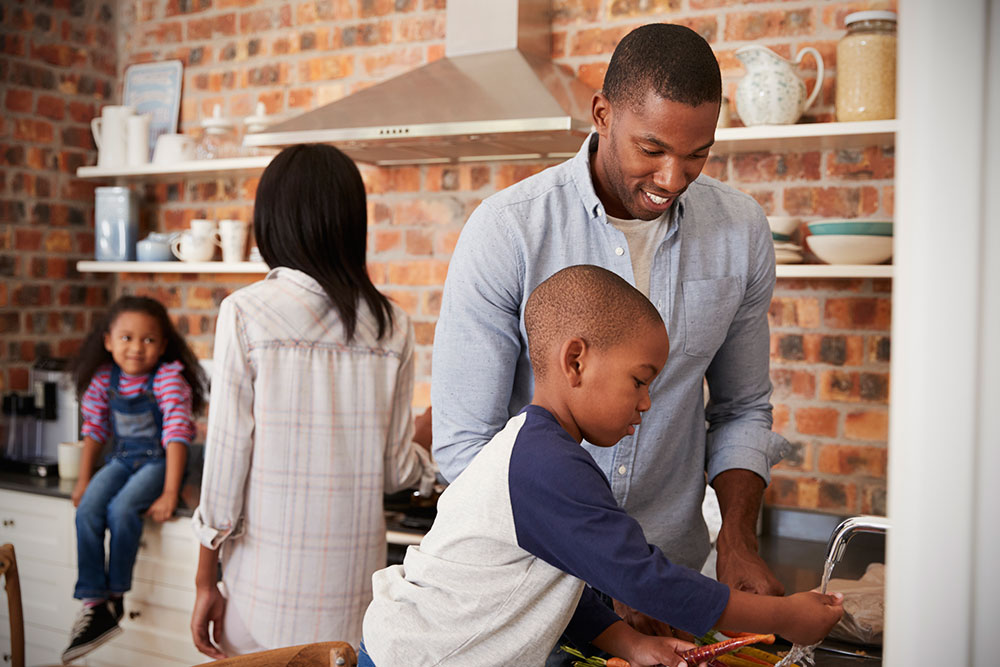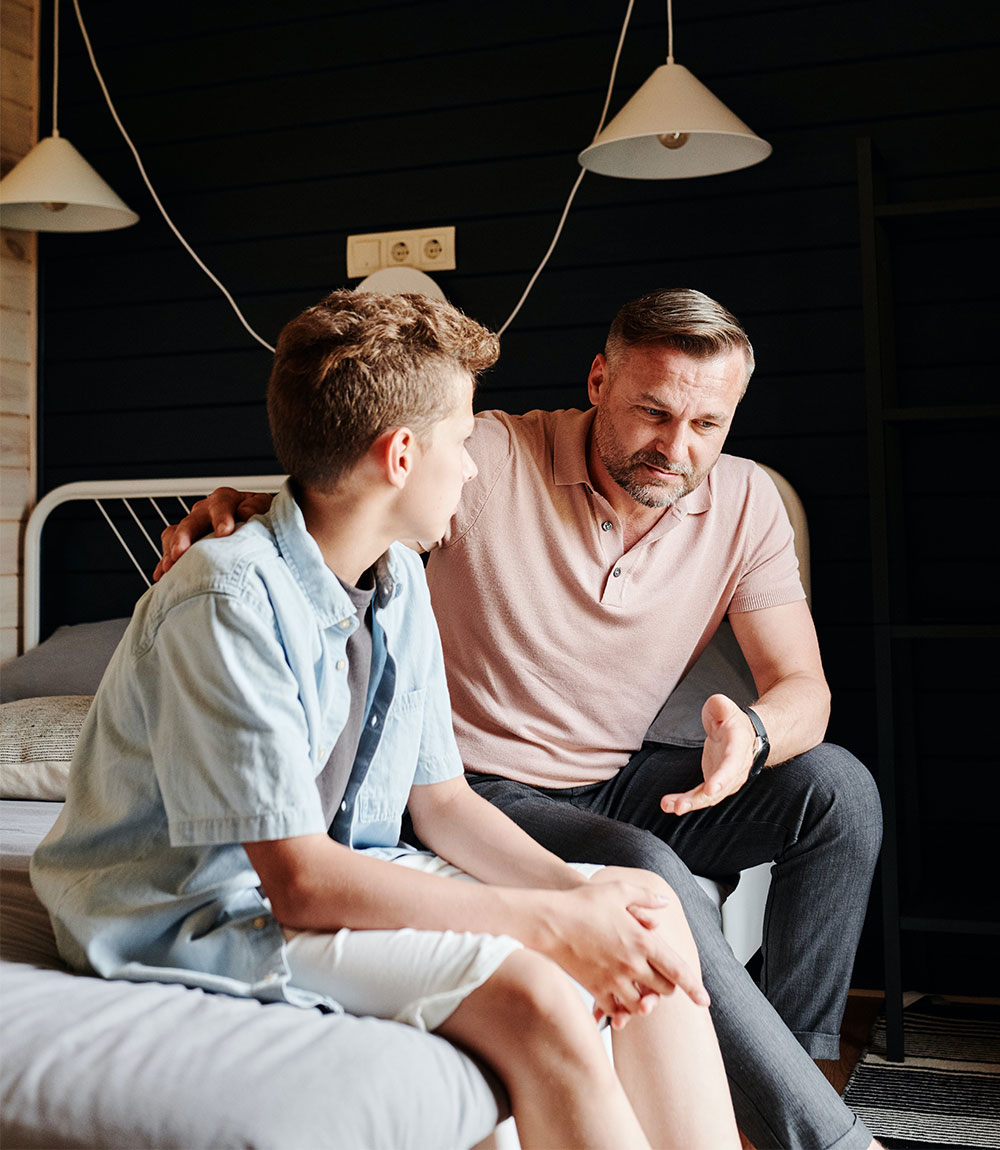Welcome back to Part 9 of our 9-part series.
If you parent kids with ADHD, odds are you are tired of feeling overwhelmed and frustrated by the chronic behavioral challenges you encounter.
During this series, I’m demonstrating how I used Collaborative Problem Solving® to help David and Amber develop a simple plan to help their 15-year-old son, Johnny, who not only has ADHD but also struggles with chronic challenging behavior. Something that hasn’t been done with him…until now!
Today, I’m thrilled to share the incredible results from my sessions with this brave couple, especially their first-hand account of what’s changed! As a reminder, we began meeting roughly four months ago.
David And Amber’s Big Payoff
I’m proud of David and Amber because they’re unlocking Johnny’s potential like a precious treasure on this journey! In our recent sessions, they’ve let go of their old approach to discipline that didn’t work well and sometimes made things worse.
Instead, they embraced Collaborative Problem Solving® to reshape their parenting methods. For instance, David and Amber used to think Johnny would choose–out of anger and spite–to protest their expectations.
Thankfully, they realize that Johnny’s choices are influenced by the skills he can access in difficult moments. Simply put, he can meet adult expectations when he can.
In the past, David and Amber reacted to challenging behavior right in the heat of the moment. Now, they’re taking a proactive approach and are becoming curious instead of furious–and it’s a game-changer!
For starters, they’re slowing down to identify the problems Johnny faces and needs to solve before intervening. This helps them understand:
- Why he’s struggling (skills that need developing).
- When he’s struggling (problems to be solved), and…
- What follows (his challenging behavior).
Nowadays, life in their living room is calmer and much more relaxed. David and Amber can sit down with Johnny, work together, and help him improve his skills and overcome the obstacles he’s dealing with. It’s making a significant and positive difference in their family dynamic.
Their New Game Plan for Parenting ADHD

With their newfound knowledge and Collaborative Problem Solving® as their guide, David and Amber have been relating to Johnny in an entirely new way. Their talks are rooted in:
- Empathy
- Genuine acceptance and…
- Active listening and …
… allow them to understand Johnny at a deeper level.
As a result, Johnny feels emotionally safe and respected enough to explore alternatives with his parents–something that didn’t exist before!
Amber said it best, “It’s like finding the key we’ve been looking for to help unlock his full potential!”
As of late, we discussed their three plans for handling Johnny’s challenging behavior and how using Plan B can help him build the skills he needs to solve problems independently:
Plan A, Impose your will. (e.g., “We decided…” “Because I said so…”)
Plan C, Drop it for now. (Thoughtful and planned)
Plan B, Solve problems collaboratively. (e.g., “I wonder if we… any ideas?”)
David and Amber are learning to collaborate using “Plan B” conversations—without stress, punishment, or a fancy reward system! Much to their surprise, it transforms their family time together. No more drama!
Plan B Conversations
At the cost of oversimplifying this approach, picture a Plan B conversation as a dance of understanding where David and Amber are able to 1) recognize that Johnny’s lived experience shapes his unique view of the world and nervous system, 2) and how it’s a striking contrast from theirs.
In this graceful dance, they step onto the dance floor and choose a quiet moment, allowing the rhythm of curiosity, empathy, and mutual respect to soothe their son.
Next, they express their concerns softly, opening the floor for Johnny to share his thoughts openly and without judgment.
This back-and-forth, rhythmic exchange invites even more empathy and understanding. Each exchange is an empowering moment for Johnny! In this posture, David and Amber can grasp Johnny’s unique perspective—his lived experience—on a much deeper level.
Much to their surprise, everyone learns something new about each other!
Johnny learns that his parents understand and accept him, even if they don’t fully agree with him. He learns to consider the views of his parents. At the same time, David and Amber get a better sense of what’s getting in the way of Johnny meeting their expectations.
Rest assured. This back-and-forth, rhythmic exchange is more than a chat or a talk—it’s a movement where David and Amber allow Johnny’s lived experience to impact their understanding of him.
As a result, both learn something. More importantly, it expands Johnny’s awareness of himself and the world in which he lives.
Even more, it builds bridges to his lagging skills. Makes them stronger. By embracing Johnny’s viewpoint, Mom and Dad gently guide their son toward finding solutions—as a team. With each step of this dance, something powerful happens. David and Amber nurture Johny’s growth, building vital life skills and strengthening their bond with their beloved son!
In the end, growth and development unfold as nature designed it!
The Power Of 3 Simple Steps
By demonstrating empathy, understanding, and genuine interest in Johnny’s thoughts, David and Amber nurture a deep bond of trust with him. In response, that bond encourages Johnny to eventually master the 3 steps embedded within a Plan B conversation:
Step 1: Empathize. Clarify kiddo’s concern.
Step 2: Share Adult Concern.
Step 3: Collaborate. Brainstorm, assess options, and choose a solution to try.
Ultimately, this dance helps build Johnny’s thinking skills to handle his demanding world—something he will carry for the rest of his life!
The Learning Curve
As with all the parents I guide, David and Amber ran into all the usual pitfalls of solving problems collaboratively. On one side, mastering the 3 steps embedded in a Plan B conversation might seem easy. After all, logic says there are just 3 simple steps to follow.
On the flip side, collaborating with people you love can be emotionally sticky, gooey, and messy at times. So, let’s not confuse “simple” with “easy.”
Thankfully, David and Amber recognized a central theme with this powerful approach: There’s no such thing as a failed Plan B conversation—and for a good reason!
Let’s remember that the beauty of this approach lies not just in solving problems or getting through all three steps in one sitting. The beauty is in the rhythm of collaboration, the journey of connection, and learning skills that pay dividends for life!
Of course, when David and Amber get stuck in a step or Johnny gets upset, all they need to do is circle back to Step 1 to reflect Johnny’s perspective and reassure him with calming statements like, “We’re here for you. You’re not alone.”
Through each collaborative conversation, David and Amber model and teach empathy, resilience, and the power of love and working together.
Remarkable Results

Unsurprisingly, David and Amber reported using Collaborative Problem Solving® is a game-changer in their home!
For example, Amber started a recent session by saying, “I’m so thankful we tried this approach. CPS has become an essential ingredient in our home. Life in our living room is so much better!”
Despite the initial chaos, challenging behavior, and difficult ADHD symptoms, David and Amber were starting to reap the fruits of their labor! Given Johnny’s new level of support, his skill struggles were decreasing—and here’s why.
Why Plan B Conversations Build Skills
We all know that when a kiddo’s skill set is good, Plan B conversations are a piece of cake.
However, let’s remember that Plan B conversations improve lagging skills—and reducing challenging behavior can be slow and tedious work. Yet, let’s not forget that a tough Plan B conversation is a golden opportunity for a couple of critical reasons.
Reason #1:
When Johnny avoids an invitation to talk or when Plan B comes to a crashing halt, Johnny’s lagging skills are the culprit—not poor choices.
For example, let’s say Johnny has good language and communication skills but struggles with perspective-taking, so he finds it challenging to consider the views of others.
Unsurprisingly, Johnny will have no problem with step one (Empathize) because he’s doing all of the talking and sharing his concerns about the situation. However, we shouldn’t be surprised when things come to a crashing halt upon entering step 2 (Share Adult Concerns). The reason? That’s the point at which Johnny’s parents share their concerns about the matter, which asks him to consider the views of others.
On the one hand, David or Amber won’t spend much time in step 1 and will quickly understand Johnny’s concerns. On the flip side, we can be sure that Johnny’s skill struggle with considering the views of others is going to surface in Step 2! In other words, parents and children are forced to dig in and do the hard work required in Step 2.
Remember, this step requires perspective-taking, which is difficult for Johnny! During this step, it’s critical to recognize when Johnny’s skill struggles surface and not be annoyed or surprised.
Instead, we can help him through the emotional turbulence. We can use reassurance and reflective listening to help him remain calm… or as calm as his skills allow during the conversation.
It’s essential to recognize that Plan B conversations help David and Amber recognize the specific skill that needs more time to develop. Best of all, their loving gestures of reassurance, reflective listening, and just being there for Johnny help him grow, stretch, and develop that skill.
Reason #2:
When the Plan B conversation goes awry, that moment of conflict can help David and Amber assess the situation and make the proper adjustments. Doing so can teach Johnny to relax, increase his stress tolerance, persevere, and strengthen his skills.
The Magic Starts To Happen
Given the effort David and Amber put into learning the Collaborative Problem Solving® approach, developing their plan, and applying it, here’s a sampling of what they shared with me.
(Quite frankly, this is why I love guiding people with this approach so much!)
David’s Experience
“A lot of what we do as educators is to assess a student and then decide on a solution. That’s what we do all day. Using the Collaborative Problem Solving® approach has taught me that I’m not always accurate in what I assume is why Johnny does what he does.
Having Plan B conversations with my son has been a huge eye-opener. At the core of solving problems is my son… who has a voice… and a choice… in every situation.
Thankfully, the process has 3 simple steps. Otherwise, I’d blow it. First, we listen to our kiddos and gather information. It’s all about listening, but it’s also about asking the right questions to understand his concerns… from his unique perspective.
Next, I share my concerns.
Next, the two of us work together to solve the problems. Crazy as it sounds, that parallels a lot of cutting-edge work on academic instruction these days. I feel so lucky to be able to see this kind of unique connection between CPS and very progressive, research-based, modern instruction.
But most of all, I’m glad it’s helping my son progress, and it’s helping us iron out the wrinkles in our relationship.”
Amber’s Experience
“The other day, Johnny struggled to start and complete his math homework. So, I decided to jump right into a Plan B talk and said, ‘Well, I noticed that you seem to have some difficulty doing math homework, and I’m sure there’s a good reason for it. What’s up, buddy?’
He said, ‘I’m not good at it. I keep getting stuff wrong. I’m not the best at math anymore!’
I said, ‘Oh. So, missing one of two problems makes you think you’re not good at math?’
And he said, ‘Yeah.’ I asked him for more, and he said, ‘Well, I don’t like that my classmates think can’t do it.’
I said, ‘So I’m hearing that when you miss a math problem or two, you think people believe you can’t do it.’ He said, ‘Yeah., they won’t think I’m very smart, or they’ll think I’m stupid.’
So eventually we got to talking about solutions. Johnny likes challenges. So, we talked about the fact that he could do math work that’s easy for him, or math work that’s challenging, but that if he does the challenging stuff, it’s probably going to be harder, and that he’s probably going to make some mistakes.
And he agreed that he still wanted to do the challenging stuff, but that he’d let me know if he needed help instead of giving up because he’s worried that people will think he’s stupid.
I was surprised because I thought he would say he was frustrated when he couldn’t figure that stuff out. I was blown away to find out he was worried that others would think he was dumb or stupid.”
Final Thoughts
My 22 years as a professor of psychology at Vanguard University, an ordained minister, and a therapist committed to helping individuals, couples, and educators build secure and lasting relationships have taught me a disturbing truth.
We are far more confident than correct when we use conventional approaches to motivate children to comply with our expectations. The reason is simple—we focus on challenging behavior, not lagging skills. Next, we assume misbehavior, not stress behavior or adaptive responses.
As a result, we accidentally and unintentionally try to solve the wrong problem—and everyone suffers!
Put another way, we try to solve the “misbehavior” problem at the expense of the stress-induced behavior that causes it—and everyone suffers, especially kiddos like Johnny with ADHD!
Thankfully, there’s a better way called Collaborative Problem Solving® (CPS)!
A Point To Ponder
Hearing stories like David and Amber’s warms my heart because I witness the life-changing power of this evidence-based approach.
I hope reading this 9-part series has caused you to slow down and rethink challenging behavior and how to help you parent a child with ADHD—even if you have no patience, no plan, or no clue.
Thankfully, there is a proven way, and it’s far less stressful than you think.
Picture this:
You and your kiddo, side by side, are taking on the world’s challenges together. Collaborative Problem Solving® isn’t just about finding solutions; it’s a journey of growth and connection. As your child tackles their skill struggles, they’re not just learning, they’re building resilience, confidence, and emotional intelligence.
Meanwhile, you get a front-row seat to witness their triumphs, “aha” moments, and the sparks that get ignited as they learn. Through these shared adventures, you’re not just solving problems—you’re creating memories, strengthening bonds, and nurturing a can-do attitude that will guide them through life’s twists and turns.
Solving life’s challenges as a team becomes a heartwarming dance of support and discovery, where both you and your child emerge as heroes, united by the joy of overcoming and thriving.
If you or someone you know would like to learn more about how to help behaviorally challenging kiddos, don’t hesitate to contact me! Helping families thrive is what I love to do. 😊
ADHD Counseling in Tustin, CA
If you can relate to David and Amber, you know that managing chronic, challenging behavior shouldn’t be so hard. Discover how to transform life in your living room (or classroom) with ADHD or ADD counseling in Tustin, Ca. I would love to be your guide!







